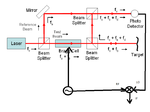elch21
Newbie level 3
Hi,
I am currently building a heterodyne laser interferometer in a Mach-Zehnder configuration. The output of my photodiodes give a phase (frequency) modulated signal with a carrier frequency of 80 MHz. The modulation signal has a maximal frequency of some KHz.
Because I am completely new to electronics and signal processing, I have some fundamental questions regarding the demodulation and processing of the signal. It would be great if someone who is experienced in those fields could give me some short answers:
- My first thought was to just digitize the whole signal and demodulate it afterwards. Unfortunately, I would need an ADC with a sampling frequency of at least some GHz, which seems to be pretty expensive. Is there any way to digitize a 80 MHz signal accurately without spending several thousand dollars?
Is it maybe possible to downconvert the signal to a certain extend in order to reduce the necessary sampling rate?
- Another option seems to be analog demodulation using a PLL and only digitizing the demodulated signal. As far as I can see, PLLs are quite cheap and should deliver a voltage depending on the phase of my signal. I know that analog processing would be more sensitive and less accurate, but I would accept this for now.
Are there any important specifications of PLLs I would have to consider in order to have the best possible results? I know that I have to pick the right input bandwith
Kind regards and thanks in advance
elch21
I am currently building a heterodyne laser interferometer in a Mach-Zehnder configuration. The output of my photodiodes give a phase (frequency) modulated signal with a carrier frequency of 80 MHz. The modulation signal has a maximal frequency of some KHz.
Because I am completely new to electronics and signal processing, I have some fundamental questions regarding the demodulation and processing of the signal. It would be great if someone who is experienced in those fields could give me some short answers:
- My first thought was to just digitize the whole signal and demodulate it afterwards. Unfortunately, I would need an ADC with a sampling frequency of at least some GHz, which seems to be pretty expensive. Is there any way to digitize a 80 MHz signal accurately without spending several thousand dollars?
Is it maybe possible to downconvert the signal to a certain extend in order to reduce the necessary sampling rate?
- Another option seems to be analog demodulation using a PLL and only digitizing the demodulated signal. As far as I can see, PLLs are quite cheap and should deliver a voltage depending on the phase of my signal. I know that analog processing would be more sensitive and less accurate, but I would accept this for now.
Are there any important specifications of PLLs I would have to consider in order to have the best possible results? I know that I have to pick the right input bandwith
Kind regards and thanks in advance
elch21
